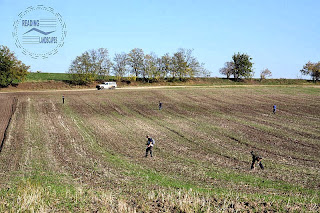6.3: The Characteristics of Surface Sites
 |
| Prospekcja powierzchniowa na węgierskich polach. Fot. S. Rzeźnik |
The methodology and aims of the study of individual sites by means of a close examination of the characteristics of their surface exposures is not generally discussed in outreach to artefact hunters and other finders. Some supporters of liaison with the artefact hunting community even claim that the removal of diagnostic finds from them makes no difference because "in many cases they are only from the ploughsoil". The suggestion is motivated by several notions, as one artefact hunter wrote on his blog:
The policy document 'Our Portable Past' makes the point clearly. The document says [p. 5] that fieldwork on surface sites is important because:
Historic England 2018, 'Our Portable Past: Guidance for Good Practice' (3rd edition, 20 February 2018)
Adapted from two posts on the PACHI blog: Thursday, 6 March 2014, Focus on UK Metal Detecting: What's this all about? UPDATE 7th March 2014: Focus on UK Metal Detecting: Not Doing the Service to History People Say'.
How can we [artefact hunters] be slated for digging up finds that are in the plough soil and have been moved around for hundreds if not thousands of years. They are not in their context, they haven't been since farmers used the land. There is nothing that can be learnt except from the item itself. [...] there is no [context] to record as the find has been dragged out of it by the plough for years [...].It is not clear why such views have persisted in the artefact hunting community for so long. There is a huge literature much of it produced by British archaeologists on surface survey techniques to recover archaeological information from surface scatters, precisely on ploughed sites. A lot of it addresses in detail the aspect of the degree to which (and when) ploughing disrupts existing patterns of surface artefacts. The frequency with which surface archaeological survey (fieldwalking) has been used as a primary technique in landscape archaeology on almost all continents for the past several decades should be proof enough that most field archaeologists think the effects of ploughing are less significant than the views expressed above would imply (there is a select reading list on these questions in a subsequent post here).
The policy document 'Our Portable Past' makes the point clearly. The document says [p. 5] that fieldwork on surface sites is important because:
material in the ploughsoil [...] has the potential to provide valuable evidence of past human activity that may not survive in situ below cultivation levels [...]. This evidence could reveal information about processes and activities such as past land use, flint-working, middening and manuring, as well as structures or parts of structures (including occupation and floor levels) whose surviving remains have already been assimilated into the ploughsoil [...]. In the case of some sites, such as flint scatters, material in the ploughsoil may be the only evidence of occupation that did not leave structural remains. These are often termed ‘sites without structures’ (Historic England forthcoming). Material from the ploughsoil can also provide evidence for the loss and use of artefacts which, when systematically recorded, can potentially provide evidence of patterns of casual loss and deliberate deposition, thereby contributing to the study of past material culture. [...] The potential of all this evidence is realised through the identification of materials within the ploughsoil [...], and by the study of the association of these materials both with each other and with other archaeological, environmental and geomorphological evidence. In circumstances where the original close vertical association of material has been disrupted by cultivation or other processes, then the full realisation of this potential is dependent on the precise record of its location in the ploughsoil [...].References:
Historic England 2018, 'Our Portable Past: Guidance for Good Practice' (3rd edition, 20 February 2018)
Adapted from two posts on the PACHI blog: Thursday, 6 March 2014, Focus on UK Metal Detecting: What's this all about? UPDATE 7th March 2014: Focus on UK Metal Detecting: Not Doing the Service to History People Say'.



Comments
Post a Comment